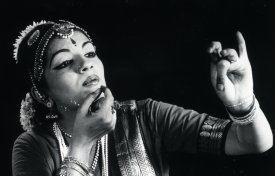
|
 |

|
 |
Radhika Shurajit - Kiran Rajagopalan, Chennai e-mail: kiran.rajagopalan@gmail.com December 10, 2009  A dancer, teacher and choreographer, Radhika Shurajit, a prime disciple of the Dhananjayans and Kalanidhi Narayanan, runs the Thrayee School of Bharatanatyam in Chennai. She has directed and choreographed dance sequences for several international television networks like BBC, TV channels in the US, South America and Singapore. She has conceived, visualized and directed the popular Bharatanatyam show 'Thaka Dhimi Tha' for Jaya TV, the music show 'Tham Thana Nam' for Tamizh Tirai Channel, 15 episodes of 'Dheem Tarikita' special program for Jaya TV. She won the Best Choreography award for the song 'Nilaa Kaigiradhu' from the film 'Indira' directed by Suhasini Mani Ratnam. What are the common problems that arise when classical dancers appear on television? How can these problems be corrected? First, they forget that they are dancing for camera, and they tend look to the right and left sides as if on stage. Instead, they should look at the side camera that is filming them and not in the side spaces. Otherwise, there is no connection with the television viewers. One must know when to look and not to look into the camera, but learning to do that can be difficult. For example, while doing abhinaya for a varnam, try doing the hands at diagonals where the cameras are positioned. When addressing a sakhi, speak to the camera filming you. Also, make-up and costume for the stage do not necessarily work for television. I often see dancers with garish make-up and overdone eyes, and they place too many flowers in their hair. Heavy chokers conceal the neck and should be avoided. Minimal jewelry and subtle make-up done especially for television are needed. Finally, there is too much running around the stage, and the camera cannot follow a dancer at that speed, making close-ups impossible. Space management on the set is crucial. What are some general guidelines to follow when selecting dance costumes for a television recording? For example, what color palettes are more suitable for television? Should real or artificial temple jewelry be used? These are my personal preferences: no costumes with big checks, garish colors, or big borders exceeding two inches. Go for subtler shades such as light green, light blue, or cream. Double shades look very pretty on film. The costume should be well-fitted while safety pins, hairclips, and hairpins should not be visible as the camera can capture all of these flaws. Real and artificial temple jewelry look equally good, but artificial white stones look bad on screen. Dancers should consult with the director and the lighting designer to discuss the set design and lighting pattern for the shoot. They should then bring more than one costume that goes with the shoot without blending into the background. Good television programs are not conducted without careful planning. Pieces are discussed before hand, and then the set and lighting are designed accordingly. Are there specific dance items that translate well on television? How does the length of the recording affect the selection of dance items? Varnam is a wrong choice for television because it is not possible to hold on to a viewer for 30 minutes continuously. Instead, opt to do a variety of items such as an opening item, a padam, and a thillana for a television audience. Also keep in mind the native audience for which the dance is being filmed by doing pieces in their language. Use subtle, but intense abhinaya as the cameras are in close proximity and can take close-ups. Avoid exaggerated facial expressions, gestures, and body language. Segments longer than 30 minutes are usually reserved for dance drama and not for solo performance recordings. It is important to remember the idea of real time in television. 30 minutes is a long time on television compared to 30 minutes on stage. What is your favorite Tamil film that features classical or semi-classical dancing? I love films! In spite of my heavy schedule of classes and recordings, I end up watching minimum of six films a week! My list is so huge, but I especially like black-and-white films in Hindi and Tamil. 'Thillana Mohanambal' is my all-time favorite not just for the dancing but also for the acting. Other films include 'Salangai Oli,' 'Nayagan,' and all of Balachandar's movies. I love Sivaji Ganesan. For theatrics and histrionics, he's the master, and I've improved my abhinaya by watching him. Contact: radhikashurajit@yahoo.com |